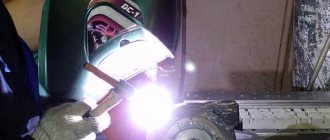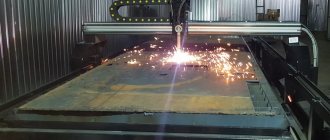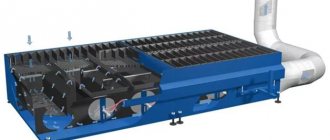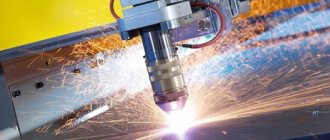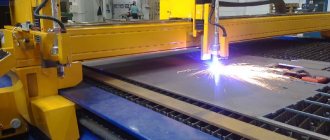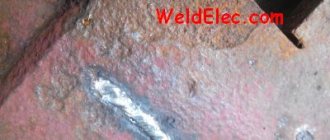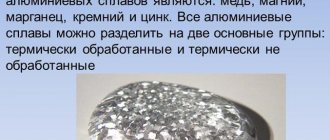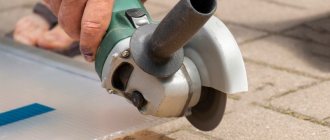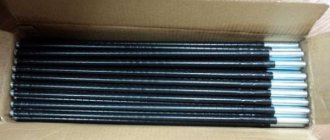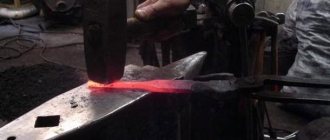[Plasma cutting] allows you to cut metal, but not with a cutter - this unit has a plasma jet.
The essence of how a plasma cutter works is this: an electric arc is formed between the nozzle, electrode or material being cut.
Gas comes out of the nozzle, it is converted into plasma after exposure to electricity.
The metal is cut by plasma, the temperature of which can reach 30 thousand degrees.
The article discusses in detail the technology of plasma cutting of metal, the principle of its operation and some nuances.
What equipment is used?
Typically two types of equipment are used:
- Transformer. Can cut metal up to 40 mm thick.
- Inverter. The efficiency is higher than that of transformer devices, however, it is impossible to cut a workpiece whose thickness is more than 30 mm.
The operating principle of these mechanisms is the same. They consist of a compressor, a power source and a plasma torch.
When choosing a tool, you need to study the markings of the device. Some devices are designed for cutting only. Other equipment allows arc welding. There are universal devices on sale, but they are inferior in quality to specialized devices.
The location of the compressor may change. In some models this element is built-in. These models have low power. A model with a built-in compressor is used in garages and small workshops. For industrial production, it is necessary to use devices with an external compressor.
Scope of use of plasma cutting
The use of plasmatrons is so popular for a reason. With relatively simple operation, as well as the not very high cost of manual equipment (unlike other cutting devices), high performance can be achieved regarding the quality of the resulting cut.
The use of plasma metal cutting has become widespread in the following production areas:
- Construction of metal structures.
- Metal processing - using plasma you can cut almost any type of metal, including ferrous, refractory and non-ferrous.
- Various areas of industry, aircraft manufacturing, capital construction of buildings, mechanical engineering, etc. - in all these areas it is impossible to do without the use of plasma cutters.
- Processing of parts and artistic forging. Using a plasma cutter you can make a part of almost any complexity.
The use of plasma cutting machines has not replaced manual installations. Thus, artistic plasma cutting makes it possible to produce unique parts that exactly correspond to the artist’s plans for use as decorative decorations for stairs, railings, fences, railings, etc.
Operating principle of a plasma cutter
The operating principle of plasma metal cutting depends on the equipment used. Before you start cutting metal sheets and workpieces, you need to study the design of the plasma torch:
- The main part is the power source. This could be a transformer or an inverter. The first option has a bulky design and low efficiency. However, the transformer allows cutting thick workpieces. The inverter has many advantages. This is a high efficiency indicator, stable operation, small dimensions.
- The plasma torch is the working part. This is a tool that consists of several parts. These include the electrode, cap, cooler and nozzle.
- Compressor - supplies a stream of air that will heat up during operation. If there is no compressor, the plasmatron may stop working.
Hoses and wires are used to connect key parts of the device.
The principle of operation of a plasma cutter is that a stream of heated ionized air is created using the equipment. The air itself ceases to be a dielectric and begins to conduct current. After turning on the device, an arc is formed, with the help of which the metal workpiece is cut. At the moment of contact between the plasma and the surface of the material being processed, it is exposed to a temperature of 30,000 degrees.
Pros and cons of a plasma cutter
When choosing a device for effectively working with metal, home craftsmen will have to make a difficult choice and decide what to give preference to - a plasma cutter for metal or a conventional gas torch. The undeniable advantages that a plasma cutter has are known:
- high performance and power;
- high-quality material processing;
- versatility;
- safety;
- environmental friendliness.
The disadvantages of plasma cutters are:
- high cost of the unit;
- limitation of material thickness;
- inability to operate two machines at the same time.
Types of plasma cutting
There are several types of manual plasma cutting:
- Use of shielding gas flow. It protects the cutting site from environmental factors. This results in a better quality cut.
- Plasma cutter using water. The liquid cools the surface being processed and the plasmatron itself. In addition, water protects the cut site from the effects of environmental factors during heating. Water prevents the molten metal from emitting harmful fumes.
- Simple. The classic way to use a plasma torch. Electric current and air flow are used for cutting. Not suitable for cutting thick metal sheets and alloy steels.
When cutting workpieces, an arc can be used, which is formed between two electrodes.
Manual plasma cutting
Types of plasma cutters
A huge assortment of cutter models is presented in professional electrical goods stores. Hand-held plasma cutters differ from each other in many ways. Which type of unit to choose - portable or stationary, programmable or manual - depends on the specific needs of the owner. Plasma cutters are divided into the following types:
- by type of energy consumption
- transformer and inverter models; - by type of contact
– non-contact and contact; - by type of work
- manual and CNC.
Technology
When carrying out work, you should adhere to the following metal plasma cutting technology:
- The nozzle, from which a stream of air will burst out, is located at the edge of the metal sheet.
- The wizard starts the device using the power button. The initial arc is turned on, which gradually turns into a cutting arc.
- The burner is tilted at 90 degrees. Cutting is done slowly and carefully.
- The master must control the appearance of splashes of molten metal. If they do not appear, it means that the metal workpiece could not be cut through.
- Do not touch the nozzle or point it towards other objects immediately after turning it off, as hot air will continue to flow from it for some time.
If you cannot cut through a metal sheet, you need to change the angle of inclination, slow down the pace of work, or increase the voltage.
Plasma cutting technology
Processing of non-ferrous alloys
When processing non-ferrous metals, various cutting methods are used, taking into account the density of the material, its type and other technical indicators. To cut non-ferrous metals, the following recommendations must be followed:
- Cutting aluminum - for material up to 7 cm thick, compressed air can be used. Its use is impractical when the material density is low. High-quality cutting of aluminum sheets up to 2 cm is achieved using pure nitrogen, and with a thickness of 7-10 cm using hydrogen and nitrogen. Plasma cutting of aluminum with a thickness of more than 10 cm is carried out using a mixture of hydrogen and argon. The same composition is recommended to be used for thick-walled high-alloy steel and copper.
- Cutting stainless steels - the use of compressed air is not recommended for the work; taking into account the thickness of the material, pure nitrogen or mixtures with argon can be used. It should be taken into account that stainless steel is quite sensitive to alternating current, which can lead to changes in its structure and faster decommissioning. Stainless steel cutting is carried out using an installation that uses the principle of indirect action.
Advantages
Plasma cutters for metal are often used on construction sites and in private workshops. The demand is explained by the advantages of the plasma cutter:
- Using a plasmatron you can process different types of metals and alloys.
- There is no need to prepare the work surface. High quality processing can be achieved without cleaning the metal from rust and paint.
- By carefully and slowly moving the cutter along the surface being processed, a highly accurate cut is obtained. No scale or sagging remains.
- Even if the metal sheet is not very thick, it will not be damaged due to strong heating. This is due to the characteristics of the equipment used.
- Using a plasma cutter you can make smooth, shaped cuts.
During operation of the plasma torch, virtually no harmful substances are released, which makes the processing process safe for health.
Plasma cutting of metals is a technological process using a special tool that allows you to cut metal sheets. The choice of plasma torch depends on what materials will be processed. If the device is not selected correctly, the plasma arc will not be able to cut the metal workpiece.
How to choose a plasma torch?
To cut metal with a plasma cutter yourself, it is important to buy equipment.
Before making a purchase, it is recommended to take into account the properties and parameters of the device. They will have a great influence on the functions of the plasma torch. The price will also vary.
Plasma cutting can be done by two types of plasma cutting machines:
- Inventory - has a compact size, its operation requires a small amount of energy, the device is lightweight with an attractive design. At the same time, it does not turn on for long; voltage drops will negatively affect the device;
- Transformer - long switching time, if the voltage jumps, the plasma cutter does not fail. The size and weight of the unit are quite large; such a plasma cutter also consumes a lot of energy.
IMPORTANT TO KNOW: Methods and devices for cutting aluminum
When choosing a plasma torch for cutting with your own hands, it is recommended to pay attention to the parameters.
Such a plasma cutter will be able to maximally satisfy the needs of the master and get the job done.
Power
Depending on the characteristics of the product that needs to be cut, the power is selected. The size of the nozzle and the type of gas will also differ.
So, with a power of 60-90A, a plasma cutter can cope with metal 30 mm thick.
If you need to cut a large thickness, it is recommended to buy a plasma cutter with a power of 90-170A.
When choosing a unit, consider the current strength and voltage that it can withstand.
Time, material cutting speed
This indicator is measured in cm, which the machine can cut in 1 minute. Some plasma cutters can cut metal in 1 minute, while others can cut it in 5.
In this case, the thickness of the material will be the same.
If it is important to reduce cutting time, then it is worth considering the cutting speed. The devices differ in operating time - how long it takes to cut metal without overheating.
If it is indicated that the operating time is 70 percent, this means that the plasma cutter will operate for 7 minutes, after which it must cool down for 3 minutes.
If it is necessary to make long cuts, it is recommended to choose units with a long operating time.
Plasma cutter torch
It is worth assessing the material that will have to be cut. The plasma cutting torch must have the power to cut it efficiently.
It is worth considering that working conditions can be difficult and cutting can be intense.
It is believed that units with a copper nozzle are very durable, almost unbreakable, and are cooled by air very quickly.
Additional elements can be attached to the handles of such plasma cutters to support the nozzle tip at a certain distance. This makes the work much easier.
If a plasma cutter will be used to cut thin metal, then you can choose a unit whose burner receives air.
If you plan to plasma cut thick metal, you should prefer a plasma torch, the torch of which will be supplied with nitrogen.
External characteristics
When doing plasma cutting with your own hands, you most often choose portable plasma cutters, which are compact in size.
They are not difficult to operate without sufficient experience; shape cutting is available.
Video:
Stationary units are heavy and are designed for cutting thicker materials; their price will be correspondingly higher.
Types of plasma cutting
Plasma arc cutting is carried out using two methods.
Manual cutting
In this case, cutting metals with plasma is carried out using portable non-industrial plasma cutters containing:
- main unit with transformer and rectifier substation;
- power supply cable;
- air hose and cable for connecting the cutter;
- plasma pistol.
The principle of plasma-arc cutting
A manual plasma unit weighs a little (up to 25 kg), operates on a 220 V network, is universal, commercially available and inexpensive.
Automatic cutting
By combining cutting technology with a plasma cutter and CNC, it was possible to achieve high accuracy, quality and cutting speed. The units have great power, operate on DC power - 380 V, and are able to cut metal up to 6 cm thick.
CNC metal cutting machine
